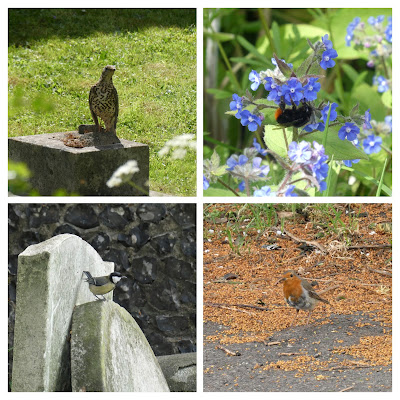The underappreciated beauty of graveyards
As somebody who likes exploring different outdoor places, when we got locked down last year I realised I needed to do something to keep life interesting with the new restrictions. I decided it was time to search out places locally that I had overlooked in the past. One type of open space that I found was still quite quiet was churchyards. The quiet and the long-established trees make them good birdwatching sites.
 |
| Jay at St Peter's Church, South Croydon |
I have discovered that while there are a lot of churches in Croydon of varying ages, relatively few of them have graveyards. Some disused graveyards have been converted into public gardens, with the gravestones moved to the edges or used to create walls.
 |
| St John's Memorial Garden, Croydon Minster |
In Croydon, the Minster graveyard was converted into a public memorial garden in 1956, in memory of those lost in World War II. There are still some gravestones along one side of the church, plus a war memorial. There's also some graves behind the church. The Minster was almost completely destroyed by a fire in 1867 and was rebuilt to a design by Gilbert Scott, an architect who designed many churches and other public buildings. He also designed St Peter's Church in South Croydon.
Inside the Minster, there are six Archbishops of Canterbury buried. Croydon has a long association with the Archbishops of Canterbury, as they used Croydon Palace (now Old Palace School) as their summer residence from medieval times. In 1807, Addington Palace was purchased as a replacement. Archbishop John Whitgift, a contemporary of Queen Elizabeth I, was very closely linked with Croydon, establishing a school and the Almshouses on North End and a charitable foundation which is still a major landowner and benefactor to the town. However, despite what I have read on Facebook, he didn't establish the Whitgift shopping centre.
St James's memorial garden on St James's Road near East Croydon is a graveyard around a former church which is now a public garden run by Croydon Council.
Another interesting example of this outside of Croydon is Postman's Park in the City of London, near the Barbican. It's a former churchyard where there is now a small pond with a fountain and fish, some green space and seating, and the fascinating Memorial to Heroic Self-Sacrifice. This is a wall covered in tiles which commemorate ordinary people who died during attempts to save others.
One of these was a Constable Robert Wright of Croydon, who was killed while trying to save a woman from a fire on North End in April 1893. He apparently left a wife and young child.
 |
| Flowers at St Peter's Church, South Croydon |
St Peter's Church in South Croydon has an active gardening group and the churchyard is managed to encourage wildlife. There are a wide variety of species living in and around the churchyard.
 |
| Wildlife in St Peter's churchyard |
You might think that I'd want to avoid being surrounded by reminders of death in a pandemic, but I find the older graves an interesting reminder of lives lived. Some people died in exotic locations, possibly for reasons related to colonialism. I find recent graves of young people make me feel very sad, whereas old, ivy covered, fading gravestones feel much less connected with tragedies.
I've noticed a variety of euphemisms used for death.
"passed into spirit life"
"fell asleep in Jesus"
"calmly fell asleep"
"entered the fuller life"
"passed over"
"called to higher service"
All Saints, Sanderstead sits by the highest point in Croydon and has two graveyards, either side of Addington Road.
The lower one is on the side of the hill and contains some newer graves.
All Saints, Upper Norwood also sits at a high point on Beulah Hill. Notably, outside is the grave of Robert Fitzroy, who captained HMS Beagle on its famous five year trip around the globe, with Charles Darwin. He was Governor of New Zealand and also a pioneering meteorologist who established what would later become the Met Office.
St Mary's in Addington Village has a very long history with five archbishops of Canterbury buried there, thanks to its proximity to Addington Palace. The memorial in the photo below is dedicated to these archbishops. Unfortunately, the only photos I have were taken on a rainy day in January, so I'll have to go back and get some better ones.
A short walk from the boundaries of the borough are some ancient churches in beautiful surroundings.
 |
| Chaldon Church, April 2021 |
Chaldon Church is a small church off Ditches Lane, near Farthing Downs, which has a sign dating it to 1086.
There is a well preserved medieval wall painting inside the church. Outside is a small churchyard overlooking fields.
I recently walked from Shirley through Shirley Heath to Spring Park, owned by the City of London. From Spring Park, I crossed Kent Gate Way (carefully - it's a busy 40mph road with no crossings) and walked along a footpath through some fields to St John's church. The field surrounding the church was home to some relaxed looking horses who came right up to the churchyard fence.
I noticed this war grave which has a dedication to "our dear daughter", who I learned was Betty Doreen Frances Coppin, from West Wickham. She was killed by a bomb at Dover train station.
Over in Beddington, St Mary's Church in Beddington Park dates from the 14th century and has a churchyard and a further memorial garden where many old gravestones have been formed into commemorative walls or placed on the ground.




















I love jays... Or I would, if they weren't so vicious :(
ReplyDelete